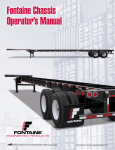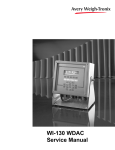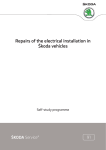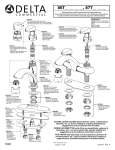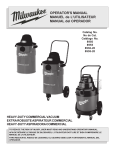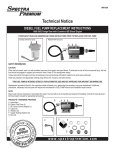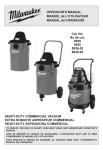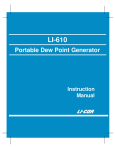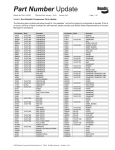Download Harbor Freight Tools 20 lb. Pressurized Abrasive Blaster Product manual
Transcript
Owner’s Manual & Safety Instructions Save This Manual Keep this manual for the safety warnings and precautions, assembly, operating, inspection, maintenance and cleaning procedures. Write the product’s serial number in the back of the manual near the assembly diagram (or month and year of purchase if product has no number). Keep this manual and the receipt in a safe and dry place for future reference. abrasive blaster 40 lb. ITEM 68992 20 lb. Visit our website at: http://www.harborfreight.com Email our technical support at: [email protected] ITEM 68994 When unpacking, make sure that the product is intact and undamaged. If any parts are missing or broken, please call 1-800-444-3353 as soon as possible. Copyright© 2012 by Harbor Freight Tools®. All rights reserved. No portion of this manual or any artwork contained herein may be reproduced in any shape or form without the express written consent of Harbor Freight Tools. Diagrams within this manual may not be drawn proportionally. Due to continuing improvements, actual product may differ slightly from the product described herein. Tools required for assembly and service may not be included. Read this material before using this product. Failure to do so can result in serious injury. Save this manual. Table of Contents Safety.......................................................... 2 Maintenance............................................... 16 Specifications.............................................. 6 Parts Lists and Diagrams........................... 18 Setup........................................................... 7 Warranty..................................................... 20 Safety Operation.................................................... 14 WARNING SYMBOLS AND DEFINITIONS This is the safety alert symbol. It is used to alert you to potential personal injury hazards. Obey all safety messages that follow this symbol to avoid possible injury or death. Setup Indicates a hazardous situation which, if not avoided, will result in death or serious injury. Indicates a hazardous situation which, if not avoided, could result in death or serious injury. Indicates a hazardous situation which, if not avoided, could result in minor or moderate injury. Addresses practices not related to personal injury. Operation IMPORTANT SAFETY INSTRUCTIONS Instructions Pertaining to a Risk of Fire, Electric Shock, or Injury to Persons WARNING – When using tools, basic precautions should always be followed, including the following: General To reduce the risks of electric shock, fire, and injury to persons, read all the instructions before using the tool. Maintenance Work Area 1. Keep the work area clean and well lighted. Cluttered benches and dark areas increase the risks of electric shock, fire, and injury to persons. 3. Keep bystanders, children, and visitors away while operating the tool. Distractions are able to result in the loss of control of the tool. 2. Do not operate the tool in explosive atmospheres, such as in the presence of flammable liquids, gases, or dust. The tool is able to create sparks resulting in the ignition of the dust or fumes. Page 2 For technical questions, please call 1-800-444-3353. Item 68992 68994 3. Avoid unintentional starting. Be sure the switch is off before connecting to the air supply. Do not carry the tool with your finger on the switch or connect the tool to the air supply with the switch on. 5. Use safety equipment. A dust mask, non-skid safety shoes and a hard hat must be used for the applicable conditions. 6. Always wear eye protection. Wear ANSI-approved safety goggles. 7. Always wear hearing protection when using the tool. Prolonged exposure to high intensity noise is able to cause hearing loss. 8. Wear heavy-duty work gloves during use. Tool Use and Care 1. Use clamps or another practical way to secure and support the workpiece to a stable platform. Holding the work by hand or against the body is unstable and is able to lead to loss of control. 2. Do not force the tool. Use the correct tool for the application. The correct tool will do the job better and safer at the rate for which the tool is designed. 3. Do not use the tool if the switch does not turn the tool on or off. Any tool that cannot be controlled with the switch is dangerous and must be repaired. 4. Disconnect the tool from the air source before making any adjustments, changing accessories, or storing the tool. Such preventive safety measures reduce the risk of starting the tool unintentionally. Turn off and detach the air supply, safely discharge any residual air pressure, and release the throttle and/or turn the switch to its off position before leaving the work area. Setup 2. Dress properly. Do not wear loose clothing or jewelry. Contain long hair. Keep hair, clothing, and gloves away from moving parts. Loose clothes, jewelry, or long hair increases the risk of injury to persons as a result of being caught in moving parts. 4. Do not overreach. Keep proper footing and balance at all times. Proper footing and balance enables better control of the tool in unexpected situations. 5. Store the tool when it is idle out of reach of children and other untrained persons. A tool is dangerous in the hands of untrained users. 6. Maintain the tool with care. Keep a cutting tool sharp and clean. A properly maintained tool, with sharp cutting edges reduces the risk of binding and is easier to control. 7. Check for misalignment or binding of moving parts, breakage of parts, and any other condition that affects the tool's operation. If damaged, have the tool serviced before using. Many accidents are caused by poorly maintained tools. There is a risk of bursting if the tool is damaged. 8. Use only accessories that are identified by the manufacturer for the specific tool model. Use of an accessory not intended for use with the specific tool model, increases the risk of injury to persons. Operation 1. Stay alert. Watch what you are doing and use common sense when operating the tool. Do not use the tool while tired or under the influence of drugs, alcohol, or medication. A moment of inattention while operating the tool increases the risk of injury to persons. Safety Personal Safety 1. Tool service must be performed only by qualified repair personnel. 2. When servicing a tool, use only identical replacement parts. Use only authorized parts. Item 68992 68994 3. Use only the lubricants supplied with the tool or specified by the manufacturer. Do not use any lubricants with this tool. For technical questions, please call 1-800-444-3353. Page 3 Maintenance Service Air Source 1. Safety Never connect to an air source that is capable of exceeding 200 psi. Over pressurizing the tool may cause bursting, abnormal operation, breakage of the tool or serious injury to persons. Use only clean, dry, regulated compressed air at the rated pressure or within the rated pressure range as marked on the tool. Always verify prior to using the tool that the air source has been adjusted to the rated air pressure or within the rated air-pressure range. 2. Never use oxygen, carbon dioxide, combustible gases or any bottled gas as an air source for the tool. Such gases are capable of explosion and serious injury to persons. Save these instructions. Symbols and Specific Safety Instructions Setup Symbol Definitions Symbol no .../min Property or statement Symbol Property or statement No-load speed NPT National pipe thread, tapered Revolutions or reciprocation per minute NPS National pipe thread, straight Operation PSI Pounds per square inch of pressure ft-lb Foot-pounds of torque BPM Blows per minute CFM Cubic Feet per Minute flow SCFM Cubic Feet per Minute flow at standard conditions WARNING marking concerning Risk of Eye Injury. Wear ANSI‑approved eye protection. WARNING marking concerning Risk of Hearing Loss. Wear hearing protection. WARNING marking concerning Risk of Respiratory Injury. Wear NIOSH‑approved dust mask/respirator. WARNING marking concerning Risk of Explosion. Specific Safety Instructions Maintenance 1. The warnings and precautions discussed in this manual cannot cover all possible conditions and situations that may occur. It must be understood by the operator that common sense and caution are factors which cannot be built into this product, but must be supplied by the operator. 2. WARNING: This product, when used for abrasive blasting and similar applications, produces chemicals known to the State of California to cause cancer and birth defects (or other reproductive harm). (California Health & Safety Code § 25249.5, et seq.) Page 4 WARNING: The brass components of this product contain lead, a chemical known to the State of California to cause birth defects (or other reproductive harm). (California Health & Safety code § 25249.5, et seq.) 3. Only use with accessories rated to handle the forces exerted by this tool during operation. Other accessories not designed for the forces generated may break and forcefully launch pieces. 4. Attach all accessories properly to the tool before connecting the air supply. A loose accessory may detach or break during operation. For technical questions, please call 1-800-444-3353. Item 68992 68994 7. Use this tool with both hands only. Using tools with only one hand can result in loss of control. 6. Install an in-line shutoff valve to allow immediate control over the air supply in an emergency, even if a hose is ruptured. 8. Do not lay the tool down until it has come to a complete stop. Moving parts can grab the surface and pull the tool out of your control. Silicosis and Aluminum Oxide Warnings 1. Prohibit silica sand (or other substances containing more than 1% crystalline silica) as an abrasive blasting material and substitute less hazardous materials. 2. Conduct air monitoring to measure worker exposures. 4. Practice good personal hygiene to avoid unnecessary exposure to silica dust. 6. Use respiratory protection when source controls cannot keep silica exposures below the NIOSH REL. 7. Provide periodic medical examinations for all workers who may be exposed to crystalline silica. 8. Post signs to warn workers about the hazard and to inform them about required protective equipment. 9. Provide workers with training that includes information about health effects, work practices and protective equipment for crystalline silica. 10. Report all cases of silicosis to State health departments and to OSHA or the Mine Safety and Health Administration (MSHA). Vibration Precautions This tool vibrates during use. Repeated or long-term exposure to vibration may cause temporary or permanent physical injury, particularly to the hands, arms and shoulders. To reduce the risk of vibration-related injury: 1. Anyone using vibrating tools regularly or for an extended period should first be examined by a doctor and then have regular medical check-ups to ensure medical problems are not being caused or worsened from use. Pregnant women or people who have impaired blood circulation to the hand, past hand injuries, nervous system disorders, diabetes, or Raynaud's Disease should not use this tool. If you feel any symptoms related to vibration (such as tingling, numbness, and white or blue fingers), seek medical advice as soon as possible. 2. Do not smoke during use. Nicotine reduces the blood supply to the hands and fingers, increasing the risk of vibration-related injury. 3. Wear suitable gloves to reduce the vibration effects on the user. 4. Use tools with the lowest vibration when there is a choice. 5. Include vibration-free periods each day of work. 6. Grip tool as lightly as possible (while still keeping safe control of it). Let the tool do the work. 7. To reduce vibration, maintain tool as explained in this manual. If abnormal vibration occurs, stop immediately. Save these instructions. Item 68992 68994 Setup 5. Wear washable or disposable protective clothes at the work site. Shower and change into clean clothes before leaving the work site to prevent contamination of cars, homes and other work areas. Operation NIOSH recommends the following measures to reduce crystalline silica exposures in the workplace and prevent silicosis and silicosis-related deaths: 3. Use containment methods such as blast-cleaning machines and cabinets to control the hazard and protect adjacent workers from exposure. For technical questions, please call 1-800-444-3353. Page 5 Maintenance WARNING! Abrasive blasting with sand containing crystalline silica can cause serious or fatal respiratory disease. Exposure to crystalline silica may cause silicosis (a serious lung disease), cancer and death. Exposure to aluminum oxide (a dust generated from material removing processes) can result in eye, skin and breathing irritation. Always use a NIOSH (National Institute for Occupational Safety and Health) approved respirator and safety goggles. Avoid skin exposure. Proper ventilation in the work area is required. Read and understand the 10 recommended measures below to reduce crystalline silica exposures in the workplace and prevent silicosis and silicosis related deaths. Safety 5. Obey the manual for the air compressor used to power this tool. Functional Description Specifications Safety Item Air Pressure 68992 68994 60~125 PSI Maximum Air Pressure Air Inlet 125 PSI 1/4″ -18 NPT Average Air Consumption Required Air Hose Abrasive Capacity 6~25 CFM 3/8″ or larger 40 lb. 20 lb. Setup Air Valve Filler Cap Filler Cap Safety Valve Safety Valve Air Valve Throttle Valve Throttle Valve Operation Abrasive Valve Trigger Valve Nozzle Abrasive Valve Trigger Valve Figure A: 68992 Components and Controls Nozzle Figure B: 68994 Components and Controls Maintenance Page 6 For technical questions, please call 1-800-444-3353. Item 68992 68994 Initial Tool Set Up/Assembly 68992 Assembly Instructions Note: Wrap 3 to 4 turns of thread seal tape on all airline connections. Make sure all joints are securely tightened. Note: For additional information regarding the parts listed in this section, refer to the 68992 Parts List and Diagram on page 18. Pipe (13) Intake Manifold (14) O-Ring (11) Figure C Hose Connector (20) Tank (1) Nipple Connector (16) Abrasive Valve (18B) assembly Abrasive Valve (18B) Abrasive Outlet Pipe (22) 1. Attach Abrasive Valve (18B) assembly’s Nipple Connector (16) to bottom of Tank (1). Barbed fitting of Abrasive Outlet Pipe (22) should face away from Handle Bar brackets. See Figure C. Figure D Setup Filler Cap (12) Air Hose (21) 2. Attach the end of the Pipe (13) to Intake Manifold (14). See Figure D. 3. Thread the other end of the Pipe (13) into the top of the Tank (1), as shown. NOTE: When tightened, parts connected to the Pipe (13) should have the orientation shown in Figure D. 4. Attach the male end of the Air Hose (21) to the Abrasive Outlet Pipe (22) underneath the Tank and tighten (not shown). 5. Attach female end of Air Hose (21) to Hose Connector (20) of Gauge Assembly. Operation Tank (1) Safety Read the entire Important Safety Information section at the beginning of this manual including all text under subheadings therein before set up or use of this product. Maintenance 6. Put O-Ring (11) into Filler Cap (12). Screw the Filler Cap (12) onto the fill port of the Tank (1). See Figure D. Item 68992 68994 For technical questions, please call 1-800-444-3353. Page 7 Handle Grips (7) Cotter Pin (3) Axle (5) Safety Handlebars (6) Bolts (8) Cotter Pin (3) Foot (4) Nut (9) Abrasive Hose (24) Wheel (2) Figure E 7. Slide Handle Grips (7) onto the Handlebars (6). See Figure E. Setup 8. Attach Handle Bars to Tank using Bolts (8) and Nuts (9). The Handle Bars must curve back and the holes at the bottom must be parallel to each other. See Figure E. 9. Slide open end of Abrasive Hose (24) onto Abrasive Outlet Pipe (22). Secure in place using Clamp (23). Figure F 10. Attach the Foot (4) to the Tank using a Cotter Pin (3). See Figure F. 11. Attach one Wheel (2) to the Axle (5) using a second Cotter Pin. 12. Slide the Axle through the holes in the bottom of the Handlebars. 13. Attach the other Wheel to the Axle using the remaining Cotter Pin. Safety Valve (10) Operation Tank (1) Figure G 14. Thread the Safety Valve (10) into the hole at the top of the Tank. WARNING! To prevent serious injury and death from explosion: Do not thread anything other than the Safety Valve (10) into the hole provided at the top of the Tank (1). Maintenance 15. After assembly, use a wrench to make sure all threaded connections are tight. Page 8 For technical questions, please call 1-800-444-3353. Item 68992 68994 68994 Assembly Instructions Note: Wrap 3 to 4 turns of thread seal tape on all airline connections. Make sure all joints are securely tightened. Safety Note: For additional information regarding the parts listed in this section, refer to the 68994 Parts List and Diagram on page 19. 1. Place the Tank (1) on a table. 2 le Tab 4 3 Figure H 5. Thread the Air Inlet assembly into the top of the Tank as shown in Figure J. 6. Attach the Air Hose (13) to the Hose Connector (12). 2. Slide each Leg (4) onto a post as shown in Figure H, and secure with a Cotter Pin (3). Setup Figure J 1 3. Thread the Safety Valve (2) into the hole at the top of the Tank (1). Operation WARNING! To prevent serious injury and death from explosion: Do not thread anything other than the Safety Valve (2) into the hole provided at the top of the Tank (1). Figure K 4. Assemble the Air Inlet assembly (see Figure I): a. Thread the Pipe (7) into the Air Valve (11). b. Thread the Nipple Connector (9) into the other side of the Air Valve (11). 7. Assemble one end of a Nipple Connector (9) into the Abrasive Outlet Pipe (22), and the other end into the Abrasive Valve (11B). See Figure K. 8. Thread another Nipple Connector (9) into the other end of the Abrasive Valve (11B), and then thread it into the Tank (1). Maintenance Figure I c. Thread the other end of the Nipple Connector (9) into the T-Connector (8). d. Thread the Air Inlet (10) into the other side of the T-Connector (8). e. Thread another Nipple Connector (9) into the bottom of the T-Connector (8). f. Thread a Throttle Valve (11A) onto that Nipple Connector (9). g. Thread the Hose Connector (12) into the Throttle Valve (11A). Item 68994 68992 68994 For technical questions, please call 1-800-444-3353. Page 9 Safety 15 Figure L 9. Assemble the Nozzle Assembly (see Figure L): 22 16 14 a. Thread the Nozzle Valve (11C) onto the Adapter (16). b. Thread a Nipple Connector (9) into the other side of the Nozzle Valve (11C). c. Onto the other end of the Nipple Connector (9), add Nozzle Gasket (19) and a Nozzle (18A – 18D). d. Thread the Nozzle Capnut (17) on over the Nozzle. 14 Figure M 10. Attach the nozzle assembly to the Abrasive Hose (15), using the Clamp (14) to secure them together. Setup 11. Use another Clamp (14) to attach the other end of the Abrasive Hose (15) to the Abrasive Outlet Pipe (22). See Figure M. 12. Connect the Air Hose (13) to the Abrasive Outlet Pipe (22). 13. After assembly, use a wrench to make sure all threaded connections are tight. Operation Maintenance Page 10 For technical questions, please call 1-800-444-3353. 68994 Item 68992 68994 To prevent serious injury from explosion: Use only clean, dry, regulated, compressed air to power this tool. Do not use oxygen, carbon dioxide, combustible gases, or any other bottled gas as a power source for this tool. 2. Attach an air hose to the compressor's air outlet. Connect the air hose to the air inlet of the tool. Other components, such as a coupler plug and quick coupler, will make operation more efficient, but are not required. WARNING! To prevent serious injury from accidental operation: Do not install a female quick coupler on the tool. Such a coupler contains an air valve that will allow the air tool to retain pressure and operate accidentally after the air supply is disconnected. 5. Turn on the air compressor according to the manufacturer's directions and allow it to build up pressure until it cycles off. 6. Adjust the air compressor's output regulator so that the air output is enough to properly power the tool, but the output will not exceed the tool's maximum air pressure at any time. Adjust the pressure gradually, while checking the air output gauge to set the right pressure range. 7. Inspect the air connections for leaks. Repair any leaks found. 8. If the tool will not be used at this time, turn off and detach the air supply, safely discharge any residual air pressure, and release the throttle and/or turn the switch to its off position to prevent accidental operation. Note: Residual air pressure should not be present after the tool is disconnected from the air supply. However, it is a good safety measure to attempt to discharge the tool in a safe fashion after disconnecting to ensure that the tool is disconnected and not powered. Maintenance Note: Air flow, and therefore tool performance, can be hindered by undersized air supply components. The air hose must be long enough to reach the work area with enough extra length to allow free movement while working. 4. Close the in-line shutoff valve between the compressor and the tool. Setup Note: An oiler system should not be used with this tool. The oil will mix with the material being propelled, causing poor results. 3. Turn the tool's throttle or switch to the off position; refer to Operation section for description of controls. Operation 1. Incorporate a filter, regulator with pressure gauge, dryer, in-line shutoff valve, and quick coupler for best service, as shown on Figure N on page 12 and Figure O on page 13. An in-line shutoff ball valve is an important safety device because it controls the air supply even if the air hose is ruptured. The shutoff valve should be a ball valve because it can be closed quickly. Safety Air Supply Item 68992 68994 For technical questions, please call 1-800-444-3353. Page 11 Description Non-lubricated Tools A Air Hose Filter Regulator Lubricator (optional) Coupler and Plug Leader Hose (optional) Air Cleaner / Dryer (optional) Air Adjusting Valve (optional) Maintenance A B C D E F G H Operation Lubricated Tools B B C C A A E E F H Connects air to tool Prevents dirt and condensation from damaging tool or workpiece Adjusts air pressure to tool For air tool lubrication Provides quick connection and release Increases coupler life Prevents water vapor from damaging workpiece For fine tuning airflow at tool G D Function Setup Figure N: Portable Air Supply Setup Safety Page 12 For technical questions, please call 1-800-444-3353. Item 68992 68994 Item 68992 68994 For technical questions, please call 1-800-444-3353. Page 13 A B C D E F G H I J K L M N O F Description F E I I J Operation N K J H Setup Function H L L M O Safety For noise and vibration reduction Secures air compressor in place Isolates sections of system for maintenance For vibration reduction Distributes air to branch lines To drain moisture from system Brings air to point of use Connects air to tool Prevents dirt and condensation from damaging tool or workpiece Adjusts air pressure to tool For air tool lubrication Provides quick connection and release Increases coupler life Prevents water vapor from damaging workpiece For fine tuning airflow at tool Non-lubricated Tools C C Vibration Pads Anchor Bolts Ball Valve Isolation Hose Main Air Line - 3/4″ minimum recommended Ball Valve Branch Air Line -1/2″ minimum recommended Air Hose Filter Regulator Lubricator (optional) Coupler and Plug Leader Hose (optional) Air Cleaner / Dryer (optional) Air Adjusting Valve (optional) B A Maintenance B A C D G Lubricated Tools Slope Figure O: Stationary Air Supply Setup F Operating Instructions Read the entire Important Safety Information section at the beginning of this manual including all text under subheadings therein before set up or use of this product. Safety Inspect tool before use, looking for damaged, loose, and missing parts. If any problems are found, do not use tool until repaired. Tool Set Up TO PREVENT SERIOUS INJURY FROM ACCIDENTAL OPERATION: Close all Valves, detach the air supply, safely discharge any residual air pressure in the tool (see After Blasting: on page 15), and close all Valves again before performing any procedure in this section. To prevent serious injury: Do not adjust or tamper with any control or component in a way not specifically explained within this manual. Improper adjustment can result in tool failure or other serious hazards. Setup Abrasive Selection The type of abrasive selected effects the time required to blast clean a given surface area. Particularly for large surfaces, test one or more of the following abrasives to determine which is most effective: a. Silicon Carbide WARNING: Do not use sand or other blasting materials that contain crystalline silica. Note: Check to ensure the abrasives are dry and clean so that they do not clog the unit. Note: The Nozzle size depends on grit of media used. The larger sizes are best suited to glass beads and walnut shells, while smaller sizes are best suited for fine aluminum oxide. Change the nozzle as needed to suit the abrasive. b. Aluminum Oxide c. Glass Beads d. Walnut Shells Operation Loading Abrasive 1. Wear protective gear including a NIOSH-approved respirator. 2. Close the Air Valve, Abrasive Valve, and Trigger Valve. 3. Remove Filler Cap. 4. Insert Funnel into Tank and pour in abrasive (up to 3/4 full). Do not fill more than 3/4 of the Tank. Note: If humidity in your region is 90% or more, only fill the tank halfway and check the Water Trap Filter (part 17 for item 68992, sold separately for item 68994) more frequently. 5. Re-attach Filler Cap securely. 6. Turn on the compressor and set the regulator to the pressure recommended for this Blaster (60~125 PSI). CAUTION! Do not exceed 125 PSI. Workpiece and Work Area Set Up Maintenance 1. Designate a work area that is clean and well‑lit. The work area must not allow access by children or pets to prevent distraction and injury. 2. Route the air hose along a safe route to reach the work area without creating a tripping hazard or exposing the air hose to possible damage. The air hose must be long enough to reach the work area with enough extra length to allow free movement while working. Page 14 3. Secure loose workpieces using a vise or clamps (not included) to prevent movement while working. 4. There must not be hazardous objects (such as utility lines or foreign objects) nearby that will present a hazard while working. For technical questions, please call 1-800-444-3353. Item 68992 68994 General Operating Instructions 2. Close all four Valves, then connect air supply. 3. Open Air Valve. Check for any air leaks at the Filler Cap. Replace O-Ring if leaking. 4. Fully open the Abrasive Valve. 5. Point the Nozzle at the work so that the abrasive will strike the surface of the work at about a 45° angle. 6. Grip the Discharge Hose firmly, and QUICKLY open the Trigger Valve fully. CAUTION: Do not attempt to regulate air/abrasive mixture discharge rate with the Trigger Valve. Doing so will ruin it. To stop in the middle of operation, QUICKLY close the Trigger Valve fully. WARNING! Keep Nozzle pointed in a safe direction until the blaster is completely shut down. 8. Close Air Valve, Abrasive Valve, and Throttle Valve. 9. Quickly open the Trigger Valve fully. Allow abrasive and any compressed air to leave the Nozzle. Safety 1. WARNING! Wear ANSI-approved safety goggles and NIOSH-approved respirator under blasting hood, and heavy-duty canvas gloves when operating the Abrasive Blaster. After Blasting: 10. Close Trigger Valve. 11. Close all Valves. 12. Pull out on ring on Safety Valve to make sure tank is not pressurized. 13. To prevent accidents, detach the air supply, safely discharge any residual air pressure in the tool, and close all valves after use. Clean external surfaces of the tool with clean, dry cloth. Then store the tool indoors out of children's reach. Setup Note: Both Abrasive Valve and Trigger Valve should be either fully opened or fully closed at all times. 7. Crack open slightly Throttle Valve to start blasting. Regulate THIS valve handle position for optimum blasting pressure. Note: The flow rate of the abrasive may be irregular when the unit is first started. Provided the abrasive is dry, the flow rate will stabilize in approximately one minute. Maintenance Operation Note: The impact pattern of the blast is affected by the output pressure and the distance from the workpiece. Item 68992 68994 For technical questions, please call 1-800-444-3353. Page 15 User‑Maintenance Instructions Procedures not specifically explained in this manual must be performed only by a qualified technician. Safety TO PREVENT SERIOUS INJURY FROM ACCIDENTAL OPERATION: Close all Valves, detach the air supply, safely discharge any residual air pressure in the tool (see After Blasting: on page ), and close all Valves again before performing any procedure in this section. To prevent serious injury from tool failure: Do not use damaged equipment. If abnormal noise, vibration, or leaking air occurs, have the problem corrected before further use. Cleaning, Maintenance, and Lubrication Note: These procedures are in addition to the regular checks and maintenance explained as part of the regular operation of the air-operated tool. Setup 1. BEFORE EACH USE, inspect the general condition of the tool. Check for: • loose hardware or housing, • misalignment or binding of moving parts, • cracked or broken parts, and • any other condition that may affect its safe operation. Operation 2. Daily - Air Supply Maintenance: Every day, maintain the air supply according to the component manufacturers' instructions. Drain the moisture filter regularly. Performing routine air supply maintenance will allow the tool to operate more safely and will also reduce wear on the tool. 3. When re-using abrasive, sharp edges of abrasive particles eventually become rounded and lose cutting ability. At this point replace the abrasive. 4. The parts of the Blaster that require frequent wear inspection and occasional replacement are those that carry the air/abrasive mixture. Pay particular attention to the Abrasive Hose, Gasket, the Abrasive Valve, the Trigger Valve and the Nozzles, as they will wear out much more quickly than the other pieces. 5. Abrasive Hose inspection: When new, the Abrasive Hose has 1/4″ ID. The Hose will need to be replaced when its side walls develop leaks or show blisters on the surface. WARNING! The hose could have residual abrasive or suddenly burst. Point the nozzle in a safe direction and wear all safety gear when doing this test. a. Close the Abrasive and Trigger Valves. b. Adjust the air pressure to 60~125 PSI. c. For item 68992 only, open the Air Valve. d. Open the Throttle Valve. e. Then, run your fingers along the length of the Hose. An enlarged spot (or bubble) indicates a weakened section of the Hose. Do not use the Blaster if this problem is present - replace the entire Hose first. 6. To protect the compressor and its engine or motor from damage by abrasive or dust from Abrasive blasting, keep the compressor up‑wind of the Blaster or in a separate room. Maintenance CAUTION! Air leaks in any of the above mentioned parts need to be repaired before use. Page 16 For technical questions, please call 1-800-444-3353. Item 68992 68994 2. Poor or irregular flow of the abrasive may also be due to low air pressure or a worn Nozzle. To correct, increase the air pressure (to no more than 125 PSI) and/or replace the worn Nozzle. Operation Setup 1. Excess moisture will cause the abrasive to slow or stop flowing through the Abrasive Outlet Pipe. To correct, check the abrasive by pouring a 6″ cone of abrasive on dry newspaper. After several minutes, remove the abrasive from the newspaper. Do not use the abrasive if the newspaper is moist. Safety Troubleshooting The manufacturer and/or distributor has provided the parts list and assembly diagram in this manual as a reference tool only. Neither the manufacturer or distributor makes any representation or warranty of any kind to the buyer that he or she is qualified to make any repairs to the product, or that he or she is qualified to replace any parts of the product. In fact, the manufacturer and/or distributor expressly states that all repairs and parts replacements should be undertaken by certified and licensed technicians, and not by the buyer. The buyer assumes all risk and liability arising out of his or her repairs to the original product or replacement parts thereto, or arising out of his or her installation of replacement parts thereto. Record Product's Serial Number Here: Note: If product has no serial number, record month and year of purchase instead. Note: Some parts are listed and shown for illustration purposes only, and are not available individually as replacement parts. Item 68992 68994 For technical questions, please call 1-800-444-3353. Page 17 Maintenance PLEASE READ THE FOLLOWING CAREFULLY Parts Lists and Diagrams 68992 Parts List and Diagram Safety Part 1 2 3 4 5 6 7 8 9 10 11 12 Description Tank Wheel Cotter Pin Foot Axle Handlebar Handle Grip Bolt Nut Safety Valve O-Ring Filler Cap Qty 1 2 3 1 1 2 2 4 4 1 1 1 Part 13 14 15 16 17 18 18-A 18-B 18-C 19 20 21 Description Pipe Intake Manifold Pressure Gauge Nipple Connector Water Trap Filter Air Supply Valve 3/8" Throttle Valve 3/8" Abrasive Valve 3/8" Trigger Valve 3/8" Air Inlet Hose Connector Air Hose Qty 1 1 1 5 1 1 1 1 1 1 1 1 Part 22 23 24 25 26 27A 27B 27C 27D 28 29 30 Description Abrasive Outlet Pipe Clamp Abrasive Hose Adapter Nozzle Gasket 3.6 mm Nozzle 3.2 mm Nozzle 2.7 mm Nozzle 2.4 mm Nozzle Nozzle Capnut Funnel Blasting Hood Qty 1 2 1 1 1 1 1 1 1 1 1 1 Setup Operation Maintenance Page 18 For technical questions, please call 1-800-444-3353. Item 68992 68994 68994 Parts List and Diagram Description Tank Safety Valve Cotter Pin Leg Filler Cap O-Ring Pipe T-Connector Nipple Connector Air Inlet Qty 1 1 3 3 1 1 1 1 5 1 Part 11 11A 11B 11C 12 13 14 15 16 17 Description Air Valve 3/8" Throttle Valve 3/8" Abrasive Valve 3/8" Trigger Valve 3/8" Hose Connector Air Hose Clamp Abrasive Hose Adaptor Nozzle Capnut Qty 1 1 1 1 1 1 2 1 1 1 Part 18A 18B 18C 18D 19 20 21 22 Description 3.6 mm Nozzle 3.2 mm Nozzle 2.7 mm Nozzle 2.4 mm Nozzle Nozzle Gasket Funnel Blasting Hood Abrasive Outlet Pipe Qty 1 1 1 1 1 1 1 1 Maintenance Operation Setup 1 2 3 4 5 6 7 8 9 10 Safety Part Item 68994 68992 68994 For technical questions, please call 1-800-444-3353. Page 19 Limited 90 Day Warranty Harbor Freight Tools Co. makes every effort to assure that its products meet high quality and durability standards, and warrants to the original purchaser that this product is free from defects in materials and workmanship for the period of 90 days from the date of purchase. This warranty does not apply to damage due directly or indirectly, to misuse, abuse, negligence or accidents, repairs or alterations outside our facilities, criminal activity, improper installation, normal wear and tear, or to lack of maintenance. We shall in no event be liable for death, injuries to persons or property, or for incidental, contingent, special or consequential damages arising from the use of our product. Some states do not allow the exclusion or limitation of incidental or consequential damages, so the above limitation of exclusion may not apply to you. This warranty is expressly in lieu of all other warranties, express or implied, including the warranties of merchantability and fitness. To take advantage of this warranty, the product or part must be returned to us with transportation charges prepaid. Proof of purchase date and an explanation of the complaint must accompany the merchandise. If our inspection verifies the defect, we will either repair or replace the product at our election or we may elect to refund the purchase price if we cannot readily and quickly provide you with a replacement. We will return repaired products at our expense, but if we determine there is no defect, or that the defect resulted from causes not within the scope of our warranty, then you must bear the cost of returning the product. This warranty gives you specific legal rights and you may also have other rights which vary from state to state. 3491 Mission Oaks Blvd. • PO Box 6009 • Camarillo, CA 93011 • (800) 444-3353




















